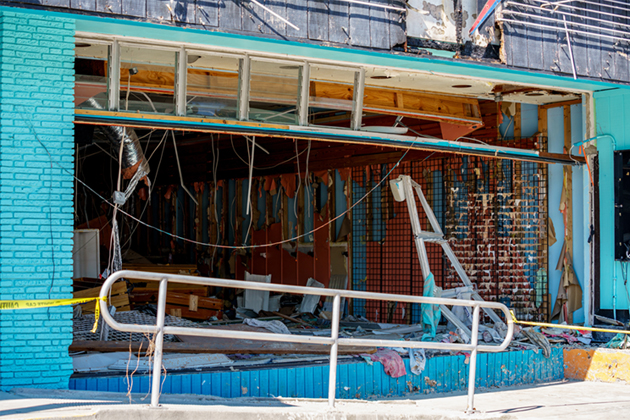
As this year’s hurricane season concludes, businesses have an opportunity to assess its impact, and rebuild, recover and safeguard against future storms. The lessons learned this year can help businesses impacted by hurricane to better navigate the claims process and ease some of the uncertainty that devastating storms can bring.
In any disaster recovery process, the health and safety of the workforce is of paramount concern but this is quickly followed by the filing of insurance claims and cleanup. Impacted owners and leaders of businesses, small and large, face physical restoration challenges while appraising the scope of loss and working with insurers in preparing claims. While undoubtedly a stressful and intimidating task, the execution of financial insurance claims, if done right, can not only help a business recover its financial footing but also create long-term natural disaster resiliency. The following are some fundamentals that business leaders can prioritize to navigate this daunting undertaking.
Mastering the Art of Recovery
The immediate job of cleaning up a storefront, nursing home, plant or hotel after a storm should be viewed as much more than a large salvage operation. It can be easy for important details to get lost in the chaotic aftermath of a tragedy, but disaster mitigation and restoration is a critical time to get all ducks in a row to prevent mistakes and surprises that might negatively impact the property damage claim. Business leaders, immediately thrust into the information gathering phase, must enlist the right people to estimate the claim, communicate with the insurance company, supervise all interactions with vendors or adjusters on site, and capture expenses and keep complete files. Ideally, these individuals have preemptively been designated as members of the disaster response team.
The business should designate a point person—a claims coordinator (who may be the business owner in a smaller organization)—to work with the insurance company every step of the way, from choosing an approved vendor for damage restoration to coordinating adjuster information requests during the insurance claims process. It is inadvisable to negotiate a complex operation with such high stakes without bringing in seasoned experts and working with insurers to find the right partners to be named in the policy. Forensic accountants can not only precisely quantify all exposures, but some can facilitate almost every step of the post-loss recovery.
Large companies will need team members from risk management, finance and operations departments as well. Open communication and good relationships with the internal personnel, insurance agents, recovery vendors and adjusters are indispensable to preventing discrepancies and disagreements.
Getting Systems in Place Immediately
Businesses need to install reliable loss and accounting systems and processes from the outset, providing an organizational framework for the myriad post-loss activities. The company should set up specific accounts, kept separate from operations and normal P&L, to capture the loss including those for materials, labor and vendor charges. The assessment of financial loss is a complicated operation requiring experience and precision. A company must be able to distinguish which property is in good shape and which is in bad shape, and to accurately comb inventory records to quantify the loss. Inadequate loss and accounting systems could jeopardize the claim recovery. Leadership teams that do not possess the experience should consider enlisting forensic accounting professionals to ease the burden and prevent costly errors. Business interruption policies, designed to reimburse businesses for income lost, consider relevant factors such as supply chain, interdependent locations, business continuity and disaster recovery plans. Implementing loss and accounting systems early on can help to maximize recovery and produce better outcomes later.
Align Your Claims Strategy
Once teams and systems are in place, it is time to identify the full scope of the loss. The most successful claims begin with the teams aligning on a claims strategy. After all, the company is trying to achieve viability so its leaders should be on the same page on the desired outcomes. When estimating damages, claim coordinators need to work with all policy terms in mind, including deductibles.
Storm and flood deductibles can be exceedingly complicated. When Hurricane Irma hit Florida in 2017, risk managers would often ask what percentage deductible means, even though it has become commonplace since Hurricane Katrina. In a catastrophic claim, percentage deductible is not merely a fixed amount based on the loss sustained; instead it factors business interruption value into total insured value. Companies do not know the deductible until after the loss is calculated, therefore an independent review at the start will help determine whether you have a recoverable claim or not—a very crucial diagnosis.
Moving forward with mitigation and restoration, policyholders should plan to put controls in place to monitor activity and to verify work has been completed to specifications and according to the terms of the agreement. The best claims teams also plan ahead on approaching the inevitable back and forth with the insurer later in the process, anticipating how the claim will be adjusted and planning to address arguments against the claim. Taking the time to develop a proper strategy will pay off at every stage of the claims process.
Businesses can realize the best outcomes with catastrophe insurers by viewing the long-tail financial recovery and claims effort as a holistic endeavor. When you conduct normal business after a tragedy, the insurance claim is your business. Any lack of diligence will only compound the anguish that a catastrophic natural disaster brings. The process is all about preventing mistakes, engaging the right professionals and eliminating surprises. With forethought, communication and patience, teams can stay on top of an arduous process, ultimately maximizing financial recovery while also preparing for the next unforeseen event.
